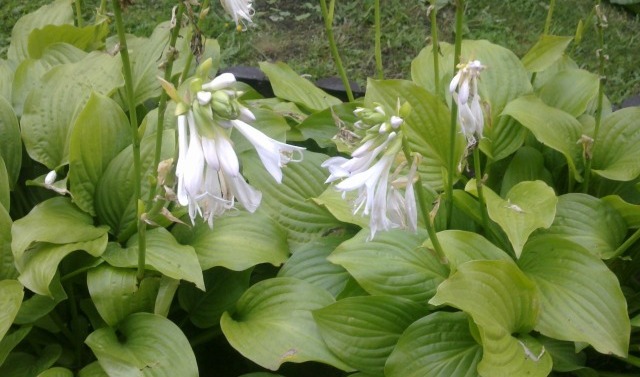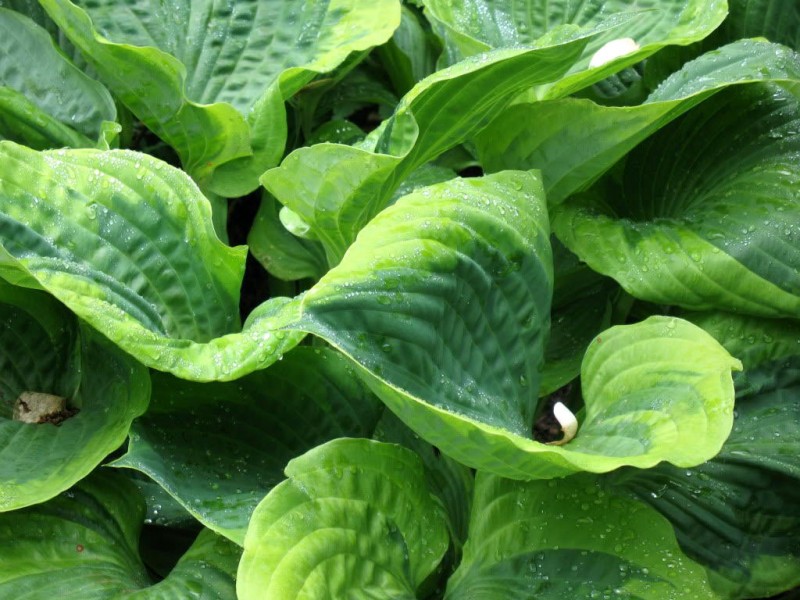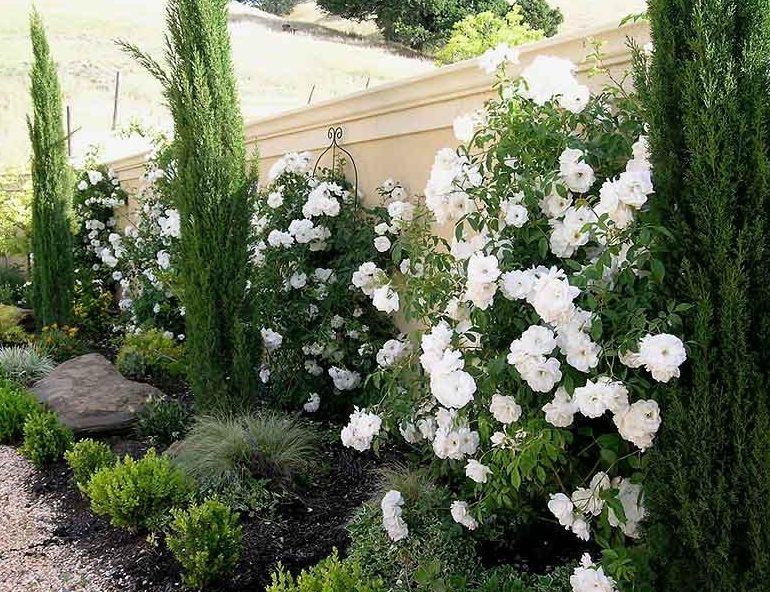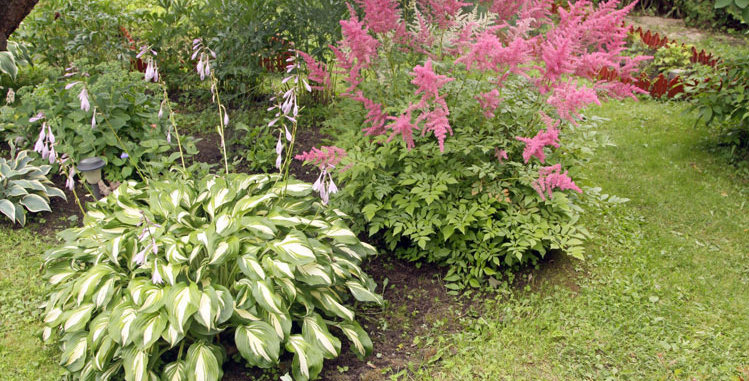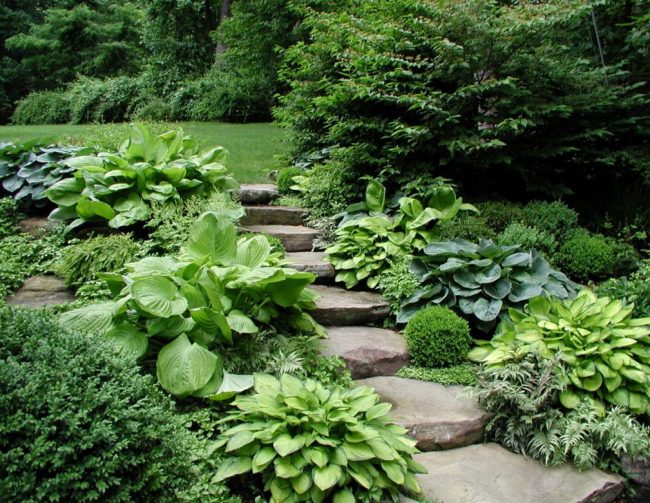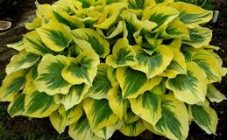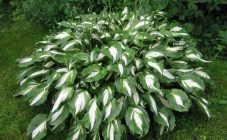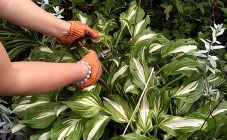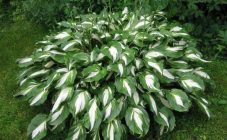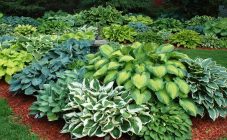Content:
- Basic rules of landscape design
- Geometry in creating a flower garden
- How beautiful it is to plant hosts in their summer cottage, in the garden
- Hosta on an alpine slide
- Why hosta changes color of leaves
- Flower garden with hosts
- What is permissible to plant in the vicinity of the host
- Landscape tricks
- Subtleties when growing
Nature has created countless different plants. Moreover, in the natural environment there is no dissonance in the combination of various neighboring cultures. With a good imagination, you can learn a lot from the wild to create a paradise on the site. For example, hosts in the garden, landscape tricks when growing it, are of great interest in decorating a flower plot. Using hosts in garden landscaping when decorating flower beds has many options. The abundance of varieties and types of this culture (about 50 species and more than 700 varieties) will help to create completely charming compositions.
Basic rules of landscape design
If you do not go into the complexity of the design, you can note for yourself some quite clear rules. They consist of:
- Unity of style. This means that both the buildings on the site and the flower beds should be in the same style. If you wanted to grow a garden in some kind of national entourage, then the entire landscape will have to be brought under this type, that is, to disguise buildings and fences, to choose consonant plants.
- Simplicity of design. This is not a matter of boringness, but the dosage of the details of the future garden. A small area, loaded with unnecessary design, causes anxiety and a sense of lack of taste in the creator of the composition.
- Domination and submission. One prominent plant is chosen as the basis for the future flower garden, and all the rest are selected for it. The goal is to achieve a single composition where each plant is designed to highlight the beauty of the main element.
Therefore, even before creating a garden, it is worth choosing the right plants, decorative details suitable for them (figurines, borders, tiles for paths, lanterns, fountains).
Geometry in creating a flower garden
The use of geometric shapes in the planning of a flower garden complements the design solutions. Depending on the task at hand, the size and shape of the site, its location, the following are used:
- Triangle rule. In a simple way, this means that first tall plants are planted, for example, trees, then lower bushes and then flowers. Shades of foliage from high to low also vary from deep green to light green, light green and yellow. Moreover, each group is planted in a triangular shape.
- Circle rule. The circle helps to distribute the color and light spectra on the site. It can be divided into 2 or more parts and in each of them plants with related shades of flowers (leaves) can be planted. Only the rule of 3 colors, 3 sizes and 3 shapes should be observed.
- Square rule. It is based on the cardinal points and implies the planting of plants according to the size and characteristics of the content.
How beautiful it is to plant hosts in their summer cottage, in the garden
To use a plant in the landscape, before breeding, you need to find a permanent place for it and decide what to plant next to the host. Transplanting the culture is undesirable.It is recommended to renew plantings after 6-10 years.
The place should be shady, calm with slightly acidic wet soil. For lush growth, you should immediately pinch the appearing pedicel. The beauty of the hosts is in the leaves, and the flowers are rather plain, so you can do without flowering.
When planting, it is important to keep in mind that every year the plant will become more luxuriant, which means that it will require good space around.
Choosing a site for planting a plant
You can grow hosts in the garden even in the center of the site, even in the background. It is only worth considering which plants the hosts are combined with. Based on the shade of the leaves, neighboring flowers are selected. For example, blue will look stylish with white, yellow with red, and other shades with green.
With the arrival of autumn, the leaves of the plant are not cut off. The bush under the snow will serve as a shelter for the root system. Foliage is removed in spring.
Hosta on an alpine slide
The basic varieties of the crop are quite large. They are of little use for alpine slides. But through the efforts of breeders, dwarf plant species have been bred. In addition, some of their properties have been improved. For example, resistance to sunburn, decorative flowers.
New host hybrids
About 20 such hybrids have been obtained. The most spectacular of them are:
- Venus is a plant with small, shiny, heart-shaped leaves;
- Shining Tot features beautiful pale lilac flowers;
- Variegata - a native of Japan, has beige leaves with light green and green borders;
- longissima Maekawa is distinguished by narrow emerald leaves with a ruffled border;
- Ground Master is the owner of narrow and long leaves, which are framed by a yellow stripe, and a very dense root system. It can be planted to strengthen the soil on the shore of the reservoir;
- Kabitan A distinctive feature of the species is lanceolate, folded leaves with a light green center and a dense green stripe along the edge.
The hosts Lemon Lime, Vanilla Cream and Geisha look amazing too. They are all yellow.
Dwarf hosts
Of the dwarf blue, the following are in great demand:
- Blue Cadet;
- Blue Moon;
- Elegans.
If it is impossible to acquire dwarf forms, it is quite possible to get by with basic varieties. On an alpine slide in the sun, their leaves will be smaller than in the shade.
Nevertheless, in the rock garden, hosts recommend placing in the shade of stones or other plants. In any case, they should not be planted at the top, it is worth choosing a place at the foot of the hill. It is even better if the flower garden approaches the reservoir.
Why hosta changes color of leaves
Leaf color change in many host species is genetically inherent. Under any conditions, they will change color during the growing season. Shades can vary from white to blue. But their change can also occur from climatic conditions or violation of the rules of content. Variable species can be divided into:
- Viridescent is when any initial spring foliage color changes to a deep green towards the end of the season;
- lutescent - these leaves change in color from the original light yellow (yellow, variegated) to dark yellow;
- albescent - host leaves from spring yellow, light green and green become white by autumn;
- bluescent - the change in shades goes from blue to green, and the transformation takes place already in the middle of the season.
There are hosts with unchanging coloration, which retain their original color of leaves all summer.
Flower garden with hosts
Having used hosts once in a garden design, you can admire the lush beautiful bushes for many years. They will decorate the flower beds even when other flowers have not blossomed. Moreover, the care for them is minimal.
Flowerbed with hosts and perennial flowers
Traditionally, hosts are planted with perennials of the type:
- badan;
- hellebore;
- day-lily.
Closer to the reservoir, the following are added to the flower bed:
- marsh iris;
- anemone;
- lungwort.
Distribution of plants by growth
Dwarf hosta varieties are planted around evergreen coniferous bushes, and the tall variety looks beautiful alone against the background of a tall tree, near water bodies, the last row of mixborders.
Medium-sized hosts look good on the front row of curbs.
Half-meter species are in harmony with gladioli, lilies, delphiniums and irises of suitable growth.
What is permissible to plant in the vicinity of the host
For example, the hosta is shade-loving, which means that it will be better to plant nearby plants that also love the shade. Here are some of them:
- roses;
- lilies;
- juniper;
- fern;
- astilba;
- rhododendron;
- tradescantia;
- iris.
The last 2 crops will look great with tall host varieties, but undersized varieties are best combined with forget-me-nots, lungwort or cuff.
You can also create compositions exclusively from host. Various types and varieties due to the variety of leaf color will help create an original design. In this case, you will not need to plant something else next to the host.
Geraniums, ferns, mountain goats, peonies, heuchera, all types of conifers are suitable for culture as neighbors.
Hosta and roses
Being the queen of flowers, the rose does not really need neighbors. She also loves open, sunny areas. But some crops are quite capable of emphasizing beauty, contributing to the preservation of moisture in the soil and preventing the attack of harmful insects. Hosta is one such plant. True, they should not be planted in close proximity to rose bushes. They are, after all, different in terms of conditions of detention. The host can pull moisture towards itself. As a companion plant, the host can be planted no closer than 30-35 cm from the rose bush. It is best to surround the planting of roses with one type of culture.
Flower garden with hosts and astilbe
There is a good compatibility in garden plantings of hosts and astilbe. The main decoration is its leaves, which are:
- green;
- yellow;
- spotted;
- striped;
- golden;
- gray-blue;
- salad.
In addition, the leaves are different in shape. There are round, narrow, heart-shaped. They also differ in size.
Not only are they different in color, but they retain their decorative effect until the very frost. Well, astilba has a wonderful feature to bloom all season, delighting with its multi-colored buds. These 2 cultures are also united by a love of shady, wet areas of the summer cottage. They feel great under the shade of tall trees, where other flowers cannot survive.
Gardeners use this tandem to decorate the abandoned dark corners of the garden and artificial ponds. In the planting of the picturesque and spreading astilba, the host brings calm and orderliness.
They can also be supplemented with bulbs, such as tulips and lilies of the valley. Sprawling hosta bushes will hide them after flowering. Thus, the neat appearance of the flower garden will be preserved.
Hosts and daylilies
They create a wonderful tandem with representatives of the daylily family. Because hostas have leaves of different shades, and daylilies have very diverse shades of flowers.
Landscape tricks
Over time, some rules have been developed for growing hosts. This can be summarized as follows:
- in the vicinity of a rose, the host should be planted in a flower bed on the north side;
- incompatibility in terms of cultivation conditions can be excluded by planting hosts in pots. Thus, a small garden with the participation of hosts can be mixed in different versions;
- from spring frosts, plants should be mulched with a thick layer of compost and nitrogen fertilizers should be applied.
Empirically, it turned out that the host in landscape design complements the flower arrangement if:
- neighbors are rich in foliage more at the top;
- other components of the flower bed have faded, wilted, and lost their foliage.
The culture also acts as a refreshing backdrop for nondescript plants and is used as the main decoration when creating a flower bed. Starting from tall species, a further design of the flower garden is created by lower representatives of the same culture or other suitable plants. The lowest varieties (dwarfs) are planted in the foreground of flower plantings (rockeries, rock gardens, flower beds).
Subtleties when growing
How beautiful to plant hosts in a flower bed? To do this, you can apply the following techniques:
- Medium-sized hosta varieties should be combined with lilac or white flowers.
- Varieties with green and blue leaves will show the best qualities only in the shade, and yellow and light green ones need a lace shade for optimal decorativeness.
The delightful beauty of the hosta bush will be its own on any flower garden. Unpretentious cultivation makes it even more desirable for gardeners. And the ability of the culture to grow in the most unpopular areas of the garden makes them even more attractive. Only they must be protected from strong drafts! A calm, moist area in the shade - and the plant will look spectacular.

